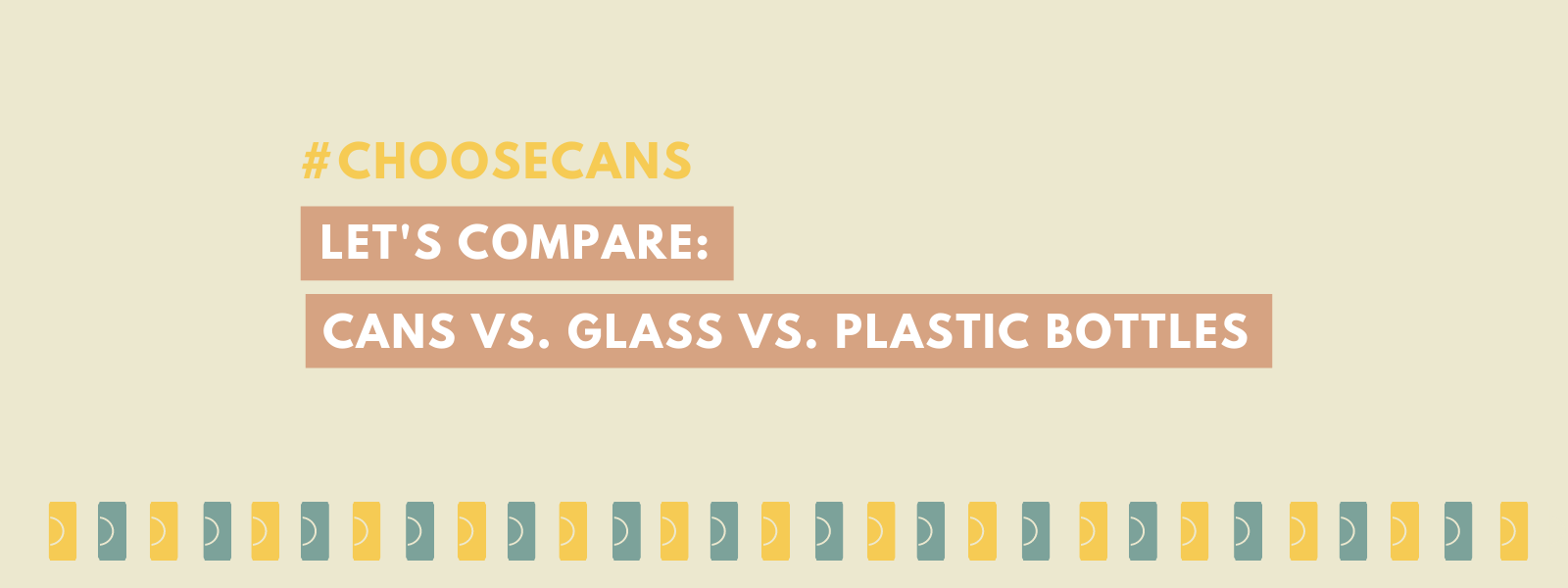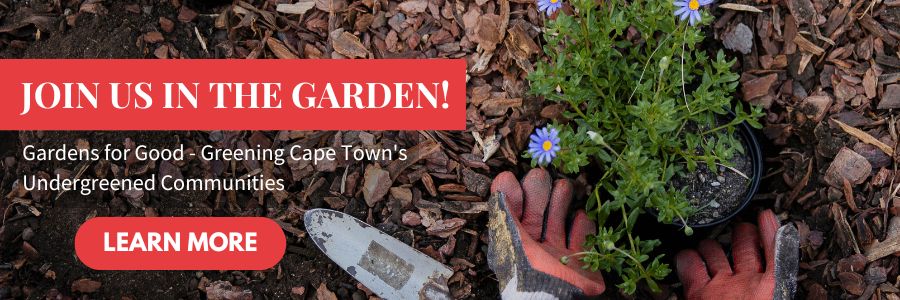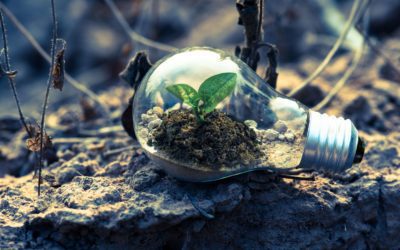
This July, Greenpop has partnered with CAN DO! to explore the environmental impact of aluminium cans, and whether cans are a more sustainable alternative to plastic. In order to do so, we also have to investigate the impact of glass and plastic.
Join us as we compare the environmental impact of glass, cans and plastic below.
The Glass Bottle
The raw materials & production
Virgin glass is made mainly from silica sand. Silica sand is the most mined resource [1] on our planet, that’s due to its use in the building industry. The problem with mining sand lies within the way and the places where it’s done. Dredging sand from a river lowers water levels, erodes the coasts and even leads to draining of parts of the rivers and connected lakes. [2] That means that important habitats get destroyed and for example migrating birds lose their nesting places and fish their breeding grounds.
Manufacturing a glass bottle is an easy process. First, the materials, mainly sand and cullets, as well as soda ash, limestone and colouring ingredients get fed into a furnace. Inside they melt facing temperatures around 1700 degrees celsius. There are two methods to make a glass bottle: The Press-Blow- or the Blow-Blow-Method [3]. The process is more energy efficient, than producing aluminium cans from virgin bauxite.
Transportation
One of the biggest disadvantages of glass packaging is its weight. Looking at 300ml bottles, we have a 400g glass container, opposite a 10g plastic bottle or a can [4]. This adds to the need for fuel when it comes to distribution from the manufacturing plant, to the filling station to then end up in the supermarket.
Use & Recycling
Glass can be easily recycled or re-used. The glass that is used in containers for beverages and food is infinitely recyclable, meaning, it won’t lose in quality if you recycle it over and over again. In this process, the glass simply gets broken down into cullets which then get put through the same process as virgin material. The reason why glass recycling is so attractive is the low melting point of recovered glass products, which makes producing a glass bottle from cullets less energy-consuming. It actually saves 50% of energy [5], compared to using newly mined sand. Also, it doesn’t degrade, meaning a recycled glass bottle can become the same kind of bottle again.
The Plastic Bottle
The raw materials & production
Nowadays, the most common material for plastic bottles is polyethylene terephthalate, better known to the public as PET or polyester. One of the main reasons for environmentalists to campaign against plastic bottles is the resources it takes to produce them. PET is a polymer resin made from terephthalic acid and ethylene glycol [6], chemicals which are won from refining and processing the fossil fuels petroleum and natural gas. They are used to form polymer chains which then create strands of PET. Those strands get cut into pellets, from there they can be molten at around 260 degrees celsius in order to be manufactured to become for example a plastic bottle.
To manufacture a plastic bottle the PET needs to be molten and formable. Because plastics lose in quality through recycling only a certain amount of recycled material can be added to the virgin PET. The mixture then gets heated and fed into moulds where they form tubes and already get the typical neck shape [7]. Those tubes are called parisons. Either the parisons are fed into moulds with the final shape of the desired product. Then a rod enters through the neck of the tube to use pressurized air to press the PET into the mould. Afterwards, the bottle, as well as the mould, need to be cooled down immediately, by either using water or carbon dioxide.
Besides the use of petroleum and natural gas, water is another resource that comes to use at several stages of the manufacturing process. Not only in the cooling and heating of the plastic itself but looking at supply chains the extraction of oil and natural gas add to a bottle’s water footprint [8].
Besides that, plastic bottles have a huge advantage, when it comes to transportation and distribution. They are relatively light and therefore the use of fuel to ship them is comparably low. As mentioned above they weigh around 40 times less than a glass bottle, when comparing same-sized containers.
Transportation
Plastic bottles are lightweight and can be packed tightly making the impact of its transportation comparable to that of aluminium cans.
Use & Recycling
Whilst plastic does not break easily, the chemicals used to make plastic bottles can be detrimental to your health, and makes it a bad candidate for re-use. But those chemicals don’t just threaten our health whilst using the bottles. When going to landfill or ending up somewhere in nature, the plastic takes a long time to break down. When it does though, these chemicals will stick to the so-called microplastics which then pose a risk to wildlife mistaking them for food.
Some types of plastic, including PET, are recyclable. Returned plastic goods get washed and cleaned, before being crushed and shredded into flakes. Those flakes can then reenter the production circle and become a new plastic product. The problem with recycling plastic is something called degradation. Most products are only recycled once or twice because in the process the material experiences a thermal breakdown [9]. It loses in quality and can’t be made into the same product it originated from, due to changed attributes and qualities. That means, after continuous recycling, the plastic is still likely to end up in landfill or worse, somewhere else. But recent developments spark some hope, looking at innovations that might bring the option to recycle plastics back to their raw materials.
The Aluminium Can
The raw materials & production
Aluminium is the most common metal on our planet. But because it binds easily with other elements and is therefore usually found in compounds which the raw aluminium can be extracted from. The main source is bauxite, which consists of silica, iron oxides, titanium dioxide and 20-25% aluminium oxide [10]. Most of the supplies can be found very close to the earth’s surface. In preparation for the mining procedures, the surrounding area needs to be cleared of all existing vegetation, rocks, etc. This obviously destroys local ecosystems and contributes to habitat loss for several animals. Recently, responsible companies have put in place recovery plans for the impacted area, aiming to restore destroyed land.
The production of aluminium cans from bauxite is an energy intensive process. However when producing aluminium cans from recycled cans, only 5% of the energy is used, because it leaves out the energy-intensive Bayer- and Hall-Héroult-processes.
Transportation
The lightweight and durable nature of aluminium is one of it’s most sustainable properties, saving a lot of fuel consumption in the transportation process.
Use & Recycling
Aluminium cans are the most recycled item in the world [11].
The ease with which cans can be recycled is one of its most important attributes. Producing new aluminium from manufacturing scraps and old end-of-life products is called secondary production. The process is so attractive because aluminium can be 100% recycled and retains its quality throughout. This process also saves a lot of energy compared to primary production.
Cans can thus be produced and recycled on an infinite loop, saving on energy consumption and reducing packaging to landfill in the long run.
——-
In our evaluation of glass, plastic and aluminium we have learnt that no packaging type is without impact. However packaging, such as glass and aluminium that can be recycled on an infinite loop have large sustainability benefits and can contribute to the recycling economy of South Africa.
In final analysis an aluminium can *made from recycled aluminium cans, has a smaller environmental impact than glass bottles, because it is lightweight, durable and more easily recycled. However glass bottles are more sustainable than cans made from virgin aluminium.
The sustainability of can thus relies on it’s recycling process and closed-loop production.
——-
This July, Greenpop has partnered with CAN DO! to explore the environmental impact of aluminium cans, and whether cans are a more sustainable alternative to plastic.
Are cans more sustainable than plastic? Should you #CHOOSECANS?
———
References:
[1] Yale Environment: The Hidden Environmental Toll of Mining the World’s Sand
[2] BBC Future: Why the world is running out of sand
[3] Thomas: How Are Glass Bottles Made
[4] Tappwater: Glass vs plastic vs aluminium – what is the most sustainable choice?
[5] University of Massachusetts Amherst: Environmental Benefits
[6] PET Resin Association: Fact Sheet – An Introduction to PET
[7] Thomas: Plastic Bottle Manufacturing Process
[8] Foodprint: The Water Footprint of Your Plastic Bottle
[9] Our World in Data: FAQs on Plastic
[10] Aluminium Leader: How aluminium is produced
[11] World Aluminium: Global Aluminium Cycle
The connection between sustainability and permaculture
The connection between sustainability and permaculture 24 SEPTEMBER, 2018 By Pierre In what can be described as a period of reawakening regarding environmental consciousness, it is important to make people aware of best practice in minimising our impact. Both...
Eco-Friendly Vehicle – How to Turn your Car into one
How to Turn your Car into an Eco-Friendly Vehicle 24 OCTOBER, 2018 By Mattea Jacobs One of the most significant contributors to harmful greenhouse gasses is transportation due to the burning of fossil fuels. Nowadays, innovative inventions like the hybrid car and the...
How To Live Off-The-Grid: Easy Steps You Can Follow
How to live off-the-grid:Easy Steps You Can Follow 3 AUGUST, 2018 By Abdul Rahman Mahayni In a world dominated by consumerism and the achievement of wealth, many have taken it upon themselves to adopt a lifestyle in which they’re wholly responsible for themselves. As...
Greenpop Foundation NPC is a registered non-profit organisation. Registration Number (NPO): 151-411 NPO.



